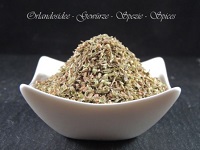
Wild Oregano Crete
Origanum vulgare subsp. hirtum — robust, citrus-savory, sun-dried aroma
Wild oregano from Crete—often called Greek “rigani”—is famed for its full, savory intensity with a bright citrus lift. Sun, sea breeze and rocky soils concentrate essential oils, making this oregano a Mediterranean essential for pizza, tomato sauces, grills and vibrant salads.
- Botany: Origanum vulgare subsp. hirtum • Family: Lamiaceae
- Part used: leaves/flowering tops, dried and rubbed
- Profile: savory, gently bitter, resinous herbs with lemony top notes
- Best for: pizza, tomato sauces, lamb, chicken, roasted veg, Greek salads, dressings
Aroma & Taste
Bold, warm and herbal with a piney backbone and a clean citrus edge. Dried Greek oregano is potent—use a light hand and build up to taste.
Culinary Uses
- Tomato classics: marinara, ragù, baked pasta; sprinkle on pizza just before serving.
- Grills & roasts: rub for lamb, chicken or pork with garlic, lemon and olive oil.
- Vegetables & legumes: roast potatoes, eggplant, zucchini, peppers; chickpeas and beans.
- Salads & dressings: whisk into lemon-olive-oil vinaigrettes; finish Greek salad with a pinch.
How to Use
- Crush to release: rub dried leaves between fingers before adding.
- Timing: add early for round depth in sauces; finish with a small pinch off-heat for brightness.
- Fresh ↔ dried guide: about 1 tsp dried ≈ 1 Tbsp fresh (3× by volume).
Dosage & Kitchen Ratios
- Tomato sauce: 1–2 tsp dried per 1 l (4 cups) sauce.
- Rubs/marinades: 1–2 tsp per 500 g (1.1 lb) meat or veg.
- Dressings: 1/2–1 tsp per 250 ml (1 cup) vinaigrette.
Pairings
Garlic, onion, lemon zest/juice, chili flakes, thyme, rosemary, basil; tomatoes, peppers, eggplant, potatoes; lamb, chicken, feta and olives.
Ingredients & Allergens
Ingredients: Wild oregano leaves/flowering tops (Origanum vulgare subsp. hirtum), dried.
Allergens: none mandatory in EN labeling for this single ingredient.
Storage & Shelf Life
Store airtight, cool, dry and away from light. Best aroma within 12–18 months. Reseal promptly after use.
Substitutes & Notes
Closest swaps: sweet marjoram (O. majorana, milder—use more) or thyme (drier, woody—use slightly less). Adjust to taste.
FAQ
Is wild oregano the same as marjoram?
No. “Wild marjoram” commonly refers to oregano; sweet marjoram is a different species with a milder, sweeter profile.
When should I add oregano to pizza?
Sprinkle a pinch after baking or in the last minute to keep aroma vivid.
Why can oregano taste bitter?
Overuse or long, high heat can emphasize bitterness—dose lightly and finish with a fresh pinch.
Merchant contact: Orlandosidee — Spice Shop (see site imprint for full company details). Email: info(at)orlandosidee.de



